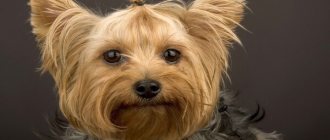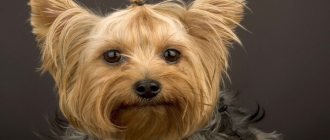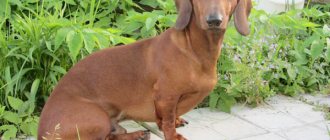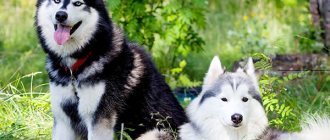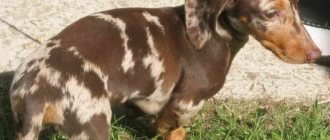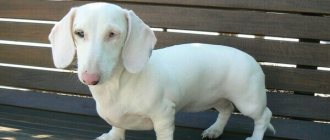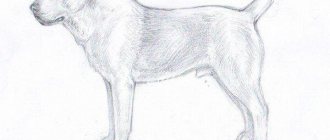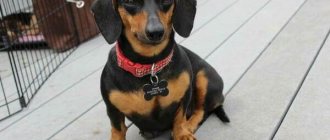Proud dachshunds, as they are called for the majestic expression of their faces. The legendary burrow hunters, with a powerful body and short powerful paws, have firmly won their place in the glorious hunting field and in the homes of non-hunting enthusiasts.
Bred in the 17th century in Germany for hunting burrowing animals, they ideally suit the main purpose of the breed. The original breed was a short-haired dachshund, whose parents were short pinschers and hounds.
Distinguished by their keen intelligence but stubborn nature, dachshunds do not require much training. All the instincts inherent in the breed by nature and breeders work perfectly without external interference. Previously, large breed dachshunds were used to hunt deer, but now they hunt foxes. Smaller breeds are indispensable in hunting rabbits and hares.
Dachshunds are good-natured and will quickly become favorites in families with children. They are devoted to their owners until their last breath and do an excellent job as a guard. They are very adaptable to different conditions, but due to their long body, it is not recommended to keep them in multi-story buildings, since the spine suffers with frequent climbing of stairs. The owner of the dachshund was Napoleon.
Origin story
The Dachshund (German name Dachshund, which means badger dog) is the oldest breed of burrowing dog. The time of their origin is hotly debated. According to one version, the history of the breed began in Ancient Egypt: archaeologists discovered images of short-legged hunting dogs.
The formation of the modern breed began in the 16th century in southern Germany. The ancestors of dachshunds are considered to be German hounds. They rewarded her with fearlessness, a keen sense of smell, intelligence and endurance. The short stature of the new breed was quickly appreciated by hunters: they realized that the dachshund would work successfully in a hole. In addition, maintaining the animal did not require any special expenses; the breed quickly spread among the burgher class.
At the end of the 18th century, the dachshund acquired features familiar to modern people. In Germany, a whole network of kennels began to function, which led to the inevitable division into hunting and decorative dogs. In 1870, the first breed standard was published.
Dachshunds were brought to Russia back in the 30s of the 18th century. Here they began to be used as decorative dogs. The breed was especially popular among intellectuals. Two world wars significantly reduced the Russian population, but the breed was completely restored.
Rare colors
White-spotted
The basis of this color is white, along which large spots of reddish-brown or black are located in a chaotic manner.
Two-color
The opposite of the white-spotted pattern: white spots on a dark background should occupy no more than 50% of the body. The color is not recognized as an official standard.
Blue
This coat color is distinguished by a noticeable bluish tint with a basic silver-steel or graphite-gray tone. Tan may be present. Such dogs are very impressive, the color looks unusual. It is not recognized by the breed standard.
Grey
This color is similar to blue, but with a slightly warmer shade of coat color, there is no bluish tint. The darkened tan can move closer to the main color until it completely merges visually.
Sable
The highlight of this rare color is the uneven color of each hair: there is a black pigment at the tips. Visually, it looks like a dark coating on the dog’s fur. This color may differ in the color of the “spraying”: the pigment will not be black, but brown.
Types of dachshunds
Modern dachshunds vary in their coat. There are currently three varieties:
- Smooth-haired dachshund. The standard smooth-haired dachshund is the oldest variety of the breed. A very effective hunter. The pile has an undercoat, which allows it to withstand temperature changes. Becomes abundant in the fall and winter months.
- Wire-haired dachshund. The rarest representative of the breed. This is due to its specific appearance. Not inferior in intelligence and working data to the standard type. It has a hard, wiry coat with a dense undercoat. There is a characteristic beard on the muzzle. The coat is rough and shaggy.
- Long-haired dachshund. The result of crossing a smooth-haired variety and a spaniel. The long coat has a dense, fluffy undercoat. The ears are decorated with fringe along the edges and tips, and the back of the limbs are decorated with fringes.
Each of the described varieties is divided by size:
- standard dachshund – height up to 25 cm, weight up to 9 kg;
- dwarf dachshund (mini) – height up to 21 cm, weight up to 5.5 kg;
- rabbit dachshund – height up to 15 cm, weight up to 3.5.
These differences are due to the purpose of each type. The rabbit dachshund had to herd hares and pull them out of the hole. Such work required small sizes. Even a standard dachshund rarely coped with this task.
Coat type
Dogs are divided into three groups based on their coat type. There are smooth-haired, long-haired and wire-haired dachshunds.
Smooth-haired dachshund
The coat of a short-haired dachshund has the following parameters:
- smooth;
- short;
- shiny;
- no bald spots;
- thick;
- fits tightly to the body;
- The length of the hair is 2 centimeters.
Longhaired dachshund
In pets with long hair, the hair lies close to the body, and forms a fringe on the ears, chest and paws. Dogs have undercoat. Their fur has a shine. Its greatest length is observed on the tail below.
Wirehaired dachshund
Their coat type is similar to smooth-haired dachshunds. However, dogs are characterized by the presence of undercoat and coarse hair. Their fur is thick and does not fit tightly on the ears, eyebrows and muzzle. The length of the villi reaches 3 centimeters.
Description of the breed
The Dachshund is a miniature, short-legged dog with a long body. It has a squat build and drooping ears. The length of the dog is 55-77 cm. In general, the breed has similar characteristics, despite the differences in coat and height. General characteristics of the breed:
- The head is elongated, wedge-shaped, the muzzle is not pointed. Weakly pronounced transition from forehead to muzzle. The forehead is of moderate latitude. The jaws are deep, well developed, with a strong grip. The lips fit tightly to the teeth. The nose is oval, colored black or brown.
- A full row of strong, white teeth. Scissor bite.
- The eyes are medium sized, oval. The eyelids are dense and well fitting.
- The body is strong with pronounced muscles. Chest of moderate width. The distance from the bottom of the chest to the ground is equal to one third of the height at the withers. The back is not sagging, straight and strong. Pronounced withers.
- The limbs are short, strong with well-developed muscles. The hind legs are set wide.
- Medium-set tail. It can be smooth or crescent-shaped.
Dachshunds do not have a standard height and weight. During the expert assessment, chest circumference is taken into account. For the standard variety it starts at 36 cm; for the dwarf variety the norm is 30-35 cm. The upper girth limit for the rabbit variety is 30 cm.
Wool
Smooth-haired dogs have a hard, short pile that fits tightly to the body. The shortest fur is in the area of the ears and muzzle. The longest is on the tail. Despite their smooth, short hair, Dachshunds have an undercoat. It is especially pronounced in the autumn and winter months.
In the wirehaired species, the guard hair is coarse and wire-like. The hair on the body and tail is especially dense. On the muzzle there is a long, stiff beard. The pile above the eyes is bushy. There are featherings on the forelimbs. The hair on the ears and face is very short and well-fitting. The undercoat is thick and abundant.
Smooth-haired dachshunds have long, shiny coats with abundant undercoat. The pile fits well on almost the entire surface of the body. The throat and lower part of the body are covered with elongated hair. The ears are decorated with fringe at the end and edges. The back side of the limbs is covered with feathers. The hair on the tail is long and thick. Because of this, it resembles a raised flag.
Colors
Dachshunds come in a wide range of colors. Characteristic colors:
- Single color. Red, yellow-red, dark red, yellow.
- Two-color. Black-brown, rusty-brown interspersed with gray, gray with yellow markings on the eyes, neck, limbs and chest.
- Tiger.
- Marble. The merle dachshund is colored red, black or gray (as the main color). There are gray or beige markings on the body. They shouldn't be too large.
- Spotted. The markings can be grey, yellow, brown, black, but should not dominate the overall coloring.
There is also an albino color. It is not recognized as a standard and is considered a deviation. These dogs have a pink or light brown nose and light or brown eyes.
Beagle
The Beagle dog is one of the oldest and smallest hounds of hunting dogs with the instinct to follow a scent and dig holes. Since ancient times, both foot and horse hunters have hunted hares with beagles. The track record of these dogs includes hunting deer, wild boar and even jackals. Beagles also do an excellent job of delivering dead birds.
Appearance of the breed
Description:
- The Beagle's physique is strong, with well-developed bones and good muscles, and an elegant body of medium length. He has a wide chest and a slightly retracted belly. The height of a beagle ranges from 33 to 40 cm, and the average weight of an adult dog ranges from 8 to 13 kg. Dogs of this breed are characterized by: an elongated curved neck, muscular paws, a well-furred and high-set tail. The dog's skin is elastic and fits tightly to the body.
- The dog's head is massive and slightly elongated. The muzzle is distinguished by a wide black nose with large nostrils, drooping lips, large dark brown eyes and strong jaws. The long ears, rounded at the ends, fit closely to the cheeks.
- The Beagle's coat is thick, short and sharp to the touch with the breed's characteristic tri-color color - white with large brown and black spots.
Character and behavior
The main character traits of the Beagle are its cheerfulness, friendliness, activity and devotion to its owners. He is characterized by extraordinary intelligence, a lively mind, and the ability to quickly make decisions. This is an independent and confident dog with a balanced and active behavior.
She doesn't have fear. The Beagle has a loud, booming bark that attracts attention and drives away unexpected guests. The dog, possessing inexhaustible energy, can hunt and play tirelessly.
Character
Despite its modest size, the dachshund is a true hunting dog. This is evident in her decisive nature. The dachshund is a perpetual motion machine: it is full of energy and does not like to sit still. This breed needs a strong, authoritative owner. If a puppy is not shown a place from childhood, he grows into an uncontrollable dog.
Like other hunting breeds, the dachshund needs training. The owner needs to teach the puppy discipline: the baby must know that he cannot sleep in the owner’s bed, beg for food from the table and pull on the leash. It is almost impossible to wean an adult dog from bad habits.
The Dachshund is capable of making independent decisions and will not act rashly. The same applies to executing commands. If the animal's desire does not coincide with the owner's order, it will refuse to carry it out. The dachshund obeys unquestioningly only if close contact is established between it and the owner. This breed is not suitable for indecisive people. Dachshunds quickly become attached to the family in which they live, but may try to set their own rules. A well-bred animal has a cheerful disposition and friendliness.
The relationship between children and dachshunds develops according to an unpredictable scenario. This breed can be aggressive towards younger family members. Dachshunds do not consider children worthy of obedience, so they treat them with indifference. However, cases of friendship between a child and a dachshund are not uncommon. If the dog becomes attached to the baby, it will protect and even educate him.
Dachshunds can get along with cats if they are taught to do so from childhood. However, this breed loves to hunt and perceives small animals as prey. Unsocialized dogs can clash with dogs of any size.
Dachshunds should only be walked on a leash. They tend to run away from their owners, especially if they spot prey. During pursuit, dogs do not respond to orders.
Dachshunds are highly trainable. They are easy to train, but at the same time stubborn. If a dog needs something, it will find a way to get it. Dachshunds are known to be cunning and manipulative.
Photo gallery
Considering the variety of varieties of this breed, there is no doubt that anyone can find a faithful friend to their liking. We invite you to verify this by viewing our photo selection.
Care and maintenance
Due to its small size, the dachshund is suitable for living in an apartment. Ideal living conditions are a private home with a spacious yard where dogs can let off steam.
A kennel or enclosure is not suitable for this breed. Their fur is not designed to retain heat. Therefore, even in a house or apartment, dachshunds need to be given a warm place, away from drafts and balcony doors.
If a dog lives in a private house, it runs the risk of being poisoned by rat poisons. Dachshunds love to hunt mice and rats, so they can catch a rodent weakened by the action of poison. Healthy ones are much more difficult to catch. If a dog bites through the skin of a poisoned rat, it may avoid infection, but if it eats the rodent, it will likely die.
Rats are carriers of rabies and infections, so their bites are very dangerous. A responsible owner must monitor the pet.
The dachshund is walked at least 2 times a day (45 minutes each) and only on a leash. A standard collar will not suit her: the structural features allow it to be easily removed. The best option is a harness vest. A standard harness pinches the sternum and leads to its deformation. This is extremely dangerous during a period of active growth.
Clothes for a dachshund are selected according to the weather. In the fall, a sweater, waterproof overalls or raincoat will be enough for her. In winter, the pet is dressed in insulated overalls. In summer there is no need for clothing. Dachshunds grow up to 10-12 months, so you will have to update your wardrobe often.
Dachshunds are a fold-eared breed, so you need to take good care of your ears. They are inspected for debris and ticks after each walk. The ears are cleaned every 3-4 weeks. The procedure is carried out using special lotions or a cotton pad soaked in warm water.
It is strictly forbidden to clean your ears with cotton swabs. They can easily damage the hearing organs.
The eyes should be examined regularly and cleared of natural secretions. To do this, use a cotton pad soaked in chamomile infusion or warm water. Movements should be directed towards the corner of the eye. Nails are trimmed once every 2-3 weeks. In dogs that spend a lot of time outside, they wear down on their own. Regular vaccination and treatment against parasites is also important.
Grooming
Caring for the coat of a smooth-haired dachshund is not difficult. From time to time you need to comb it with a rubber mitt to remove dead hairs. During seasonal molts - winter and spring - the procedure is carried out more often. The dachshund is bathed as needed. Using special shampoos - 3-4 times a year. The rest of the time, rinse with water.
Caring for the hair of a wire-haired dachshund is much more difficult. The beard should be wiped regularly after eating and walking: it is an ideal environment for the development of bacteria. If you neglect the procedure, your beard will begin to emit unpleasant odors. The wire-haired dachshund needs to be brushed regularly. During seasonal molting - every day.
The dog also needs trimming, a hygienic or fashionable haircut. They bathe her after severe contamination using special shampoos. It is recommended to give preference to cosmetics that contain silicone: this substance makes combing easier. The rest of the time, the dachshund is rinsed with warm water (without detergents). During rainy weather, the wire-haired dachshund is dressed in overalls. The dense undercoat allows this species to do without winter clothing.
Long-haired dachshunds are also regularly clipped and combed. Hygienic haircut is an essential part of grooming. It involves trimming the hair between the toes and around the paw pads, ears and groin. Bathe them 3-4 times a year using shampoo and conditioner. For minor stains, rinse it off.
Feeding
Your dachshund can be fed high-quality dry food or home-prepared meals. Modern super premium drying is made from whole meat and natural ingredients, therefore it has a beneficial effect on the dog’s health. In addition, dry food contains a whole complex of vitamins and minerals, which eliminates the need to introduce additional supplements into the diet.
Premium foods (for example, Pro Plan, Royal Canin or Hills) are made from offal and contain little whole meat. They contain allergenic corn and flavor enhancers. These products will not harm the dog's health, but will not be beneficial either.
Economy class feeds (Darling, Pedigree, Chappie, Friskies) are produced on the basis of by-products and waste from slaughterhouses. They provoke urolithiasis, poisoning and gastrointestinal diseases.
Quality feeds include:
- Brit Kea;
- Pronature;
- Original;
- First Choice;
- Dukes Farm;
- Monge;
- Wulfsblatt;
- Akana;
- Grandorf;
- Now Fresh;
- Savarra.
It is better to opt for holistic food (the last 4 items on the list). They do not contain grains or other allergenic products. The daily feed intake can be found in the table printed directly on the packaging or posted on the manufacturer’s website. It is calculated based on the dog's weight.
During dry feeding, you need to provide your pet with access to fresh water.
If the owner has the opportunity to prepare fresh dishes every day, he should include in the diet:
- low-calorie meat: beef, lamb and rabbit;
- well-cooked offal (from 3 months);
- raw bones (except poultry tubular bones);
- sea fish;
- rice, buckwheat, oats;
- cottage cheese, kefir, yogurt, natural yogurt;
- low-fat cheese;
- boiled egg (1-2 per week);
- omelette without salt and spices;
- vegetables;
- greenery;
- fruits (except grapes);
- rye crackers, biscuits and crackers without seasoning (as a treat).
The daily portion of meat should be from 30 to 50%. It depends on the activity of the particular dog. Meat can be given either boiled or raw. In the latter case, it is recommended to scald it right before serving. It is better to serve sea fish boiled, removing the head, tail, fins, bones and organs.
River fish contains worm eggs, so it is rarely given and only boiled!
The daily share of cereals is up to 20%. If the dog is fat, it is recommended to remove them from the menu. The content of vegetables in a daily serving can reach up to 50%. It is better to give them raw. Before serving, grate the vegetables. Dairy products are given as a snack. They should not be mixed with meat and vegetables.
List of prohibited products:
- pork and other fatty meats;
- boiled poultry bones and tubular bones;
- potato;
- cabbage;
- legumes;
- grape;
- milk (after 3-4 months);
- River fish;
- sausages;
- confectionery;
- fresh bread and products made from yeast flour;
- fried, salted, smoked, spicy;
- seasonings and spices.
An adult dachshund (from 8 months) needs to be fed 2 times a day. If the pet receives a meat bone, this completely replaces feeding. Some breeders recommend feeding a dog over one year of age once a day. The average daily portion is 360 g. 60 g are allocated for treats and edible rewards.
What to feed a puppy
Proper puppy care is impossible without a balanced diet. In the first 4 weeks, the baby is fed by the mother, but from the age of 1.5 months additional foods are introduced into the diet. Dry food for puppies can be given from 1-1.5 months. The main thing is to soak the granules with milk or warm water. The list of approved foods corresponds to the list for adult dogs. These brands have lines for different ages.
If the owner raises the baby on a natural diet, at the age of 1 month baby meat food, meat broths, dairy products, buckwheat or rice porridge, and boiled vegetables are added to mother’s milk (it is acceptable to give a piece of raw carrot).
At 2-3 months, the diet is expanded with buckwheat and rice porridge with the addition of poultry or beef. The meat is boiled until done. Its volume should not exceed a third of the serving. At 4-5 months, babies begin to be fed like adult dogs.
Puppies require a special diet. Babies up to 3 months are fed 5 times a day. From 3 to 8 months – three times a day. From 8 months – 2 times a day. Some people transfer their one-year-old dachshund to one-time feeding.
Estrus, mating, pregnancy, childbirth
On average, dachshunds begin their first heat cycle at the age of 8 months and repeat every 6-10 months. The frequency depends on the characteristics of the body and the psychological state of the dog. Typically, estrus lasts 3-4 weeks.
The first time a female is mated is in her third heat, a male is mated at the age of 1.5 years. If the female is not bred before the age of 6, you should continue to refuse mating. The ideal moment for mating is 12-14 days from the start of estrus. Dogs are bred only in the male's territory: the female is inclined to defend her territory, so she will be aggressive. If mating is carried out for the first time, it is recommended to consult a specialist. He will take into account all the nuances and control the process.
If everything went well, pregnancy occurs. For standard dachshunds, pregnancy lasts 63 days, for miniatures it lasts 60 days. Childbirth can last from several hours to a day. Puppies are usually born 10-40 minutes apart. After each baby, the placenta comes out.
Inexperienced owners should not give birth on their own. It is better to use the services of a veterinarian.
With hormonal problems, dachshunds experience false pregnancy. The reasons may be the production of hormones after an unsuccessful mating. Most often, symptoms appear 6-10 days after the start of estrus. False pregnancy occurs in both parous and non-parous dogs. Symptoms: sudden mood swings, swollen nipples and secretion of colostrum, building a nest for future births, picking up and licking toys in which the dachshund sees puppies.
Offspring
It is better to buy a puppy from official nurseries that have all the permits and documents. Take a closer look at the conditions in which the dogs are kept. Responsible breeders will provide decent conditions for their pets.
Puppies must have a veterinary passport and vaccinations according to age.
How to choose a puppy
Do not buy a dog at the market or secondhand, as there is a risk of purchasing a sick or non-purebred dog.
When choosing a puppy you need to pay attention to:
1 In a small dog, the tail should be smooth to the touch; already at the age of 4 weeks, the tail should meet the standard, that is, be straight. 2 At the age of 4 weeks, the correctness of the bite is assessed. 3 Puppies must have no dewclaws; they are removed in the first days after birth. 4 The puppy does not have an umbilical or inguinal hernia. This is noticeable to the naked eye. This is not a problem, but since surgical intervention will be required, you can ask for a price reduction. 5 The puppy must move actively; any difficulty walking may be a sign of problems with the spine or joints. 6 Eyes and ears must be clean. 7 Red colored puppies become lighter in color, well in this case their claws and nose should be light.
Puppy cost
The cost of a dachshund puppy depends on the class of the dog:
6-20 thousand rubles. Pet class puppy 20-40 thousand rubles. Breeding class puppy 40-60 thousand rubles. Show class puppies
Mating
The optimal age for mating is 1.5 years. At this age, dachshunds are physiologically ready to give birth. The bitch is bred on the 12-15th day of her third heat. Mating should take place on the male’s territory, so the girl’s owner must calculate the optimal time.
Responsible owners record the start and end dates of estrus. The dogs are walked together, the bitch must be muzzled. If the girl shows aggression and bites the boy, the mating will not take place. After getting to know each other, both are taken to the male’s territory, and after 1-2 days a control mating is carried out.
2 weeks before mating, pets are treated for parasites, since it is forbidden to give anthelmintic drugs during pregnancy. It is also recommended to take both dogs to the vet to make sure they are completely healthy.
Training and education
Dachshund puppies begin to be trained from the first months of life. Already at one month old, the baby has enough experience to learn the simplest rules of behavior. Training at home begins with educational work. You should not immediately teach your puppy complex commands. To begin with, he is taught the feeding and toilet routine, the rules of behavior in the apartment, he is forbidden to sleep in the master's bed and pull on the leash.
Dachshunds very quickly get used to permissiveness. If the puppy feels weak, he will not obey commands. It is especially difficult to wean an adult dachshund from stealing food from the table and getting into bed.
You need to train your dog consistently. Any team learns in 3 stages:
- in one way or another they force the dog to perform a certain action;
- if successful, the dachshund is rewarded with a treat, thereby reinforcing the positive emotions from following the command;
- reinforce the association of the command with the desired action.
Until 3 months, the baby is trained in a calm environment. The training is then moved outdoors to strengthen the team in unfamiliar conditions.
Under no circumstances should you physically punish your dog! The pet will lose trust and will not obey the owner.
Usually the dachshund has enough basic knowledge to behave well in society. If the owner wants to unleash the full potential of this breed, he can enroll the dog in special courses.
Hunting
When hunting, the dachshund transforms. She becomes a collected, passionate and merciless animal. There are cases when dachshunds rushed at large animals. Burrow hunting is very dangerous. A dog can not only die from the claws of a predator, but also be buried alive as a result of a collapse. For this reason, you should have a shovel in your hunting arsenal.
Having discovered a hole, the dachshund begins to bark at the victim and inflict stinging bites on it, forcing it to crawl to the surface. This breed is known for its death grip: the dachshund can keep its jaws closed for a long time.
At the same time, some dogs leave the victim in the hole because they lose interest in the defeated enemy.
Dachshunds hunt:
- hare;
- wild boar;
- badger;
- duck;
- fox;
- marten;
- ferret;
- ermine.
With proper training, a pack of dachshunds is capable of driving down deer and wolves.
Physical exercise
All types of dachshunds, the photographs and names of which you have already seen above, need physical activity. Daily walks are an excellent prevention of excess weight gain, which happens quite often with dogs of this breed kept as pets (not for hunting). Experts recommend walking dachshunds for short periods of time, but often, giving them plenty of time to run around. It is worth warning those who have their own country plot or house. Dachshunds, due to their hunting nature, are big fans of digging the ground.
How to toilet train
Until about 4 months, babies cannot control their urge to urinate and defecate. Despite this, the puppy needs to be toilet trained from the first months of life. To begin with, he is taught to go to the toilet at home (until all vaccinations are completed, he cannot be taken outside).
The owner must allocate a certain place in the apartment for the puppy where he will go to the toilet. This could be a waterproof diaper or a tray with high sides. In the first months of moving the puppy, it is recommended to protect it with a playpen or special fences. There you need to lay out several diapers so that the puppy gets used to doing things only on them. Then, when he gets a little older, the diaper is placed in a specially designated place. Soiled diapers are suitable for this so that the dog can find the toilet by smell. At first, misfires may occur. There is no need to punish the child; it will be enough to show dissatisfaction. The puddle is blotted with a diaper and taken to the right place. It is very important to eliminate all traces: the smell will provoke a relapse.
After the puppy has become accustomed to the toilet at home, he has received all his vaccinations, and is taught to relieve himself in the yard. He is taken outside after waking up, feeding or active play. It is very important not to leave the street until the dog is done with everything. At first, you can take the soiled diaper outside. However, you shouldn’t delay this. A couple of times is enough for the puppy to begin to associate the street with the toilet.
Diseases and life expectancy
Dachshunds are prone to excess weight and spinal diseases. Obesity is very dangerous: it increases the load on the back and leads to irreversible consequences.
The most common diseases include:
- Osteoporosis.
- Discopathy. This disease manifests itself in the displacement of intervertebral discs, which leads to compression of the spinal cord. Discopathy can be genetic or occur in sedentary dogs.
- Acanthosis nigricans. It causes skin damage, excessive pigmentation, baldness, and the formation of severe folds. In addition, the disease is accompanied by a stench. Acanthosis nigricans in a dachshund can be a consequence of a genetic pathology or frequent diathesis. Possible causes include diabetes and hypothyroidism.
- Ear mite.
- Epilepsy.
- Cataract.
- Diabetes.
- Diseases of the heart, urinary tract.
Problems with the spine are often accompanied by impaired motor activity. If your dachshund's paws fail, you should immediately consult a doctor. Treatment can be either medicinal or surgical. During the recovery period, massage, swimming and special exercises are prescribed. On average, dachshunds live 12-15 years.
Dachshund mix
The popularity of the breed and random matings inevitably lead to the emergence of mixed breeds. The most common ones include:
- A cross between a dachshund and a spaniel. This mixed breed looks like a spaniel with a long, squat body. He is distinguished by an active, perky character and a tendency to eye diseases.
- Dachshund and Chihuahua mix. This mestizo is known as the Chihuaxa. From the Chihuahua he inherited erect ears and a pocket size. The dachshund has an elongated body. These dogs do not like to be left alone and need constant communication with their owner.
- A cross between a dachshund and a toy terrier. This mestizo is similar to an ordinary dachshund, but has the character of a Russian toy. This crossbreed is becoming increasingly popular.
Mixed breeds are no worse than purebred dogs, but require special treatment. Sometimes mixing characters gives unexpected results.
Separation by coat
The indefatigable imagination of breeders and breeders divided the breed into varieties based on their coat. Today, dogs are distinguished with three different coats: smooth-haired, wire-haired and long-haired.
The most ancient are smooth-haired representatives, with fur that fits tightly to the body. The short fur is so densely packed on the animal’s body that it shimmers in different colors in the sun, shimmering like gloss. Thick and short hair perfectly protects the dog’s skin from dirt and extreme wetness.
Wirehairs have a very hard coat. And under the top coat there is a dense undercoat. A touching feature of wire-haired dogs is a small beard and mustache and eyebrows, making pets, even puppies, look like aged sages.
The long-haired dachshund is the shaggiest of all species. Soft wool, as if slightly curled in curlers, very pleasant to the touch, shiny and silky. The standard does not allow excessive curling, so representatives of this species often have straight but long hair. Certain parts of the body, such as ears, tail, hind legs, are covered with hair more densely.
How to choose a puppy
The best place to buy a puppy is a specialized nursery. Pedigree guarantees not only blood purity, but also social skills. A well-trained dog teaches puppy behavior rules. But there is a risk of stumbling upon scammers who keep dogs in terrible conditions. Therefore, in order not to regret your choice, it is recommended to visit exhibitions, get acquainted with the assortment of nurseries, and ideally, sign up for a puppy from the parents you like.
At the screenings, pay attention to the following:
- organization of living space;
- baby diet;
- mother's health and appearance;
- condition of the puppy’s coat, skin, teeth, eyes and joints;
- absence/presence of discharge from the nose and eyes;
- communication between puppies;
- children's reactions to strangers;
- activity of puppies (they should not be lethargic or hyperactive);
- set of documents and pedigree.
It is best to visit breeders with experienced owners or specialists. They will help you take into account all the nuances.
Where to buy and price
The dachshund is one of the most popular dogs in Russia, so finding a purebred puppy will not be difficult. Officially registered nurseries exist not only in cities with a population of over a million.
List of nurseries:
- Dax Design (Moscow);
- Ulayter (Moscow);
- Tornado Blaze (Moscow);
- From the Golden Storehouses (Moscow);
- From Rainbow Dreams (Rostov-on-Don);
- Svarta Pim (St. Petersburg);
- Caucasus Lake Baikal (Angarsk);
- From the Omsk Fortress (Omsk);
- Crazy Toy (Ryazan);
- Magic of the Stars (Rybinsk).
Average price for puppies: 15,000-35,000 rubles.
Nicknames
You can name a boy dachshund with either a funny or an aristocratic name: Count, Hamilton, Theodore, Zeus, Tim, Denis, Chuck, Charlie, Cactus, Sprat, Kex, Bumblebee, Shustrik. A name for a girl can be gentle or perky: Chloe, Florence, Pixie, Button, Mimi, Plusha, Toffee, Snezhka, Sophie, Donna.
Pros and cons of the breed
| + | – |
| Beautiful hunting dog | Requires special education |
| Good companion | May exhibit animal aggression |
| Easily trainable | You can only walk on a leash |
| Quickly becomes attached to the family in which he lives | Prone to spinal diseases |
| Most often, she is child-friendly | Submits only to an authoritative master |
| Suitable for apartment living | |
| Sheds moderately | |
| Suitable for active owners |
The dachshund is a small dog with the heart of a hunter. She has irrepressible energy and is able to drive a wild boar. This breed is not suitable for indecisive people and homebodies. The owner must share the interests of the pet.
Owner reviews
According to reviews from owners, the Dachshund will be an ideal companion for those owners who have a lot of free time to spend with their acquired pets. This dog is also good for hunters who regularly travel out of town to hunt rabbits or other animals that live in burrows. A properly trained dachshund will help its hunter owner return home with trophies.
